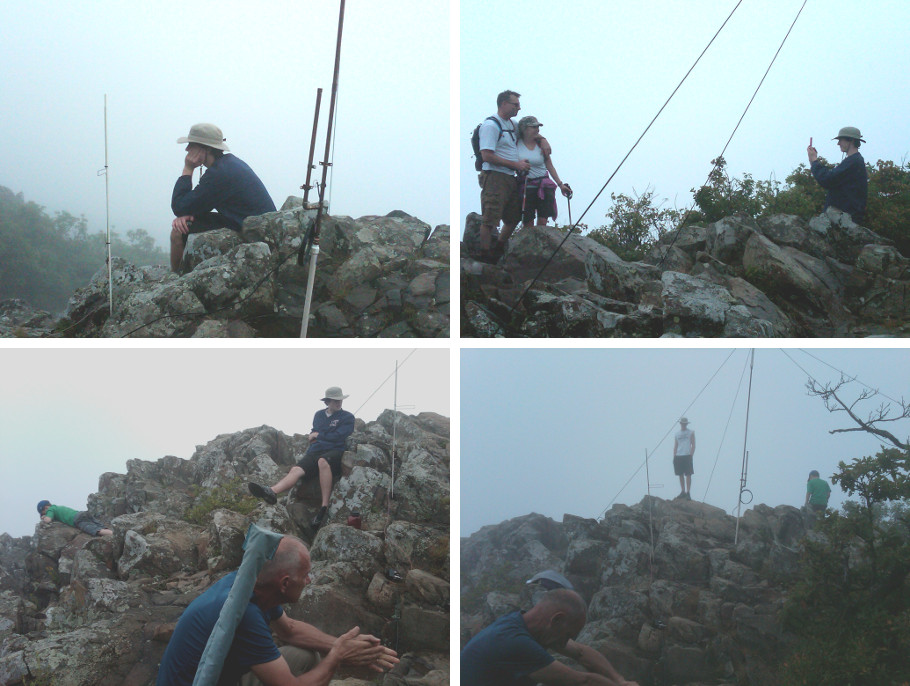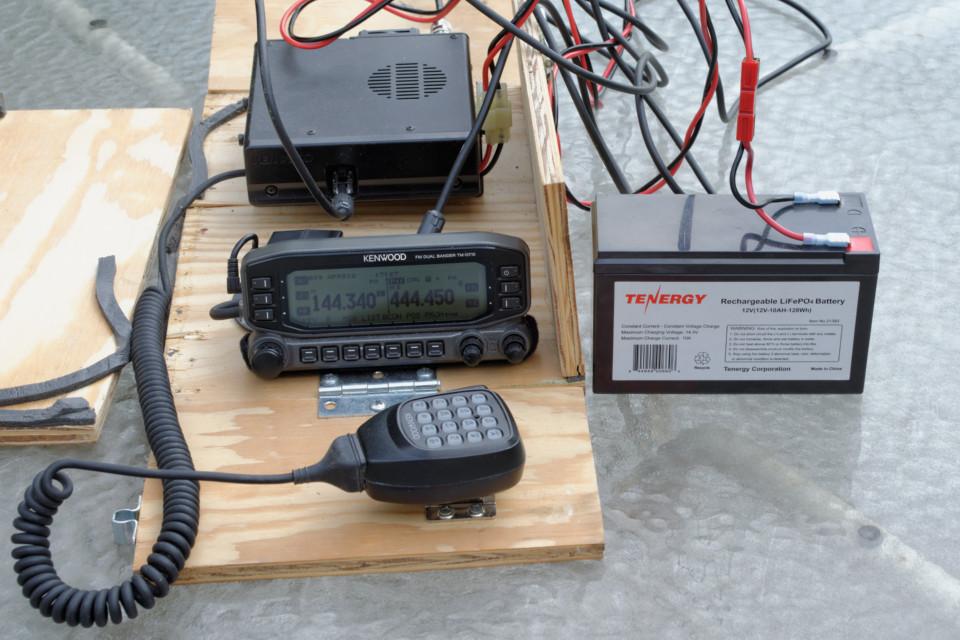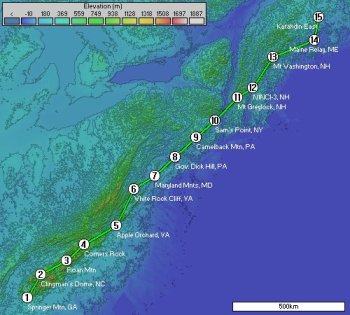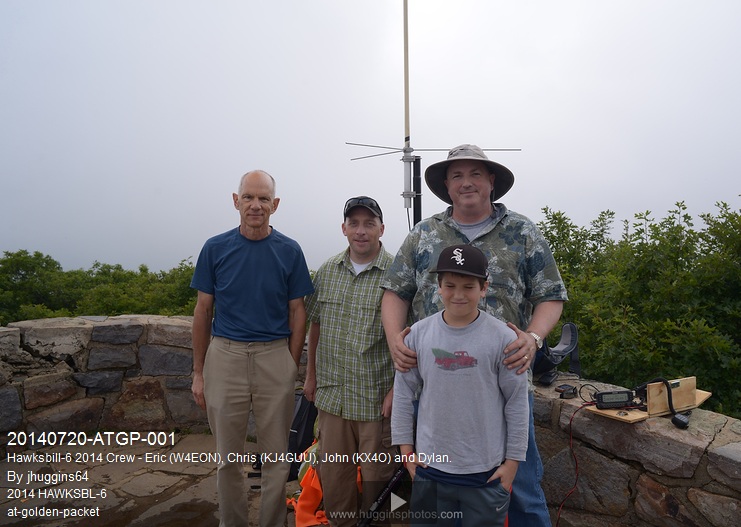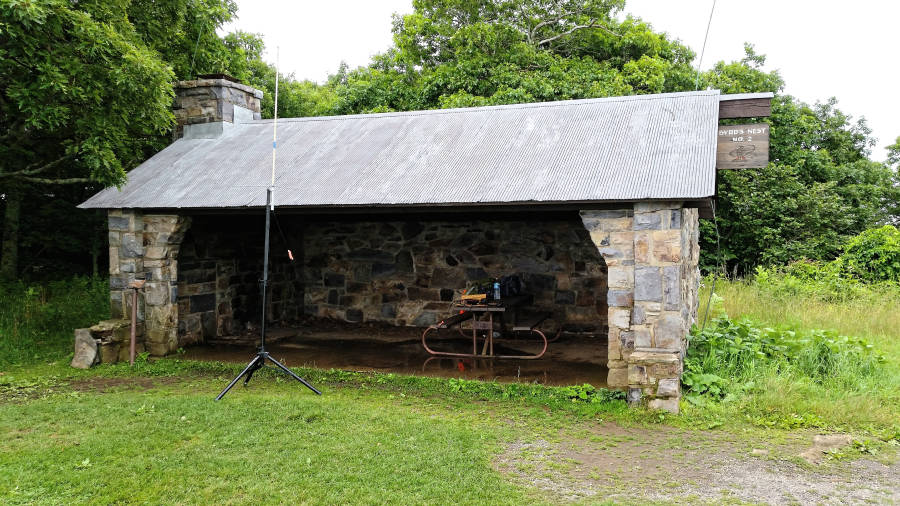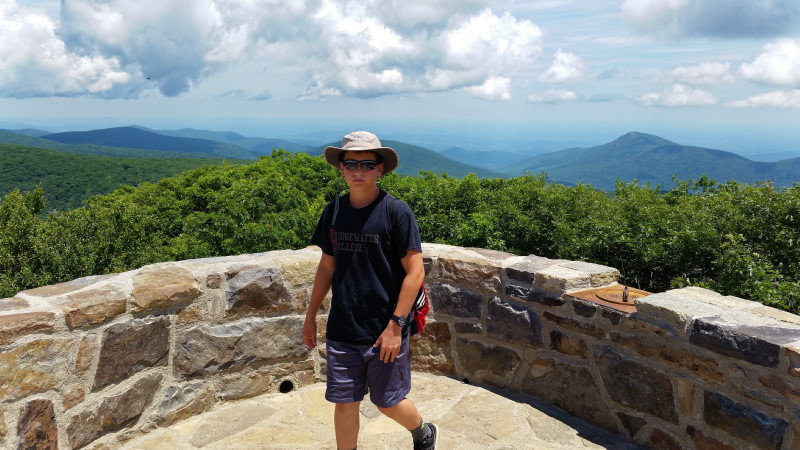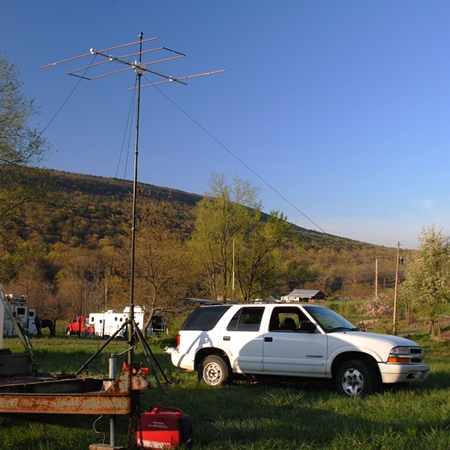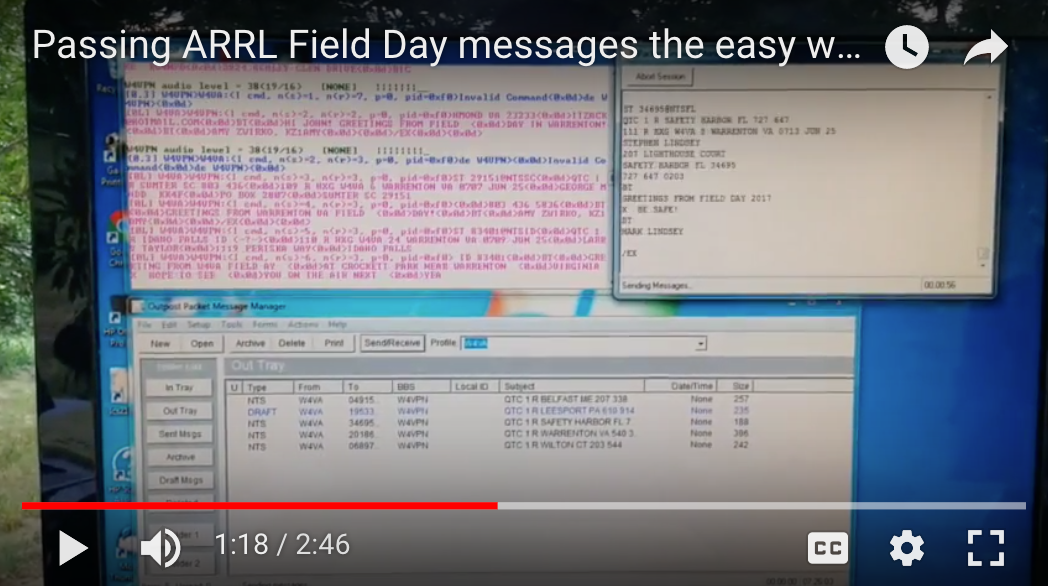Virginia hikers and hams supported the White Rock Cliffs (Station #6) of the first Annual Golden Packet Event.
Summarized, we were trying to set up APRS relay stations up and down the east coast to cover and service all points along the Appalachian Trail and surrounding areas. Some RF link analysis was performed and is available for viewing at AT_Golden_Packet_Event using the remarkable Radio Mobile program and A LOT of SRTM elevation data.
Of the fourteen stations planned several points were accessible only by foot. The White Rock Cliffs station was no exception.
So an all-call was put out for fit hams to assist in the planning and execution of placing a temporary APRS digipeater system on the cliff face of White Rock Cliffs to yield the northbound and southbound RF links. Some interest was expressed, but, in the end, kx4o and kj4faj were the only two hams to volunteer.
Preparations for Station 6 are outlined at Station 6. Highlights include:
- Enlist the aid of non-ham hikers to build up the team to safe levels
- Get a trail map of the area
- Obtain a Kenwood TM-700 or 710 APRS VHF/UHF radio
- Build a cool antenna that has some gain and can be hand carried
- Get some modern backpacks with water delivery systems
More Hikers
Several folks at work seemed to be in good shape and expressed interest in outdoor activities. I asked two who are new to the area if they would like to hike and learn about trails west of the Northern Virginia area where we live. Two accepted the challenge: Rob Searle and Jay Gundlach.
Trail Map
White Rock Cliffs is at the end of a short pipe-stem trail off the “Big Blue” trail on the border between West Virginia and Virginia. I am just as unfamiliar with this trail system as my new hiker recruits. I did not hesitate to purchase the trail Map F authored by the PATC.
Obtain an APRS Radio
Thankfully, the Golden Packet organizer loaned me a radio for this event. I like it so much that I am now in the market for a TM-710A.
Portable Antenna with Gain
The Golden Packet event is unique in that each station has to focus their efforts on just two directions: link to the next station north and a link to the next station south. Some are using two beam antennas with a power splitter/combiner. Since we had to hike our equipment to the White Rock Cliff’s site, I wanted to concentrate on a simpler omnidirectional antenna with engineering to realize higher gain in all directions. Several approaches were considered:
- Simple quarter wave GP or half-wave J-Pole – Discussed here
- 5/8ths wave J-Pole – Compared here
- Collinear J-Pole – Compared here
- Collinear 5/8ths wave J-Pole – more copper than it is worth
- 5/4 Wave Vertical – Debunked here
- Rubber Ducky Antenna – Not really considered, but is certainly an option
In the end the collinear half-wave J-Pole was the one that simulated best.
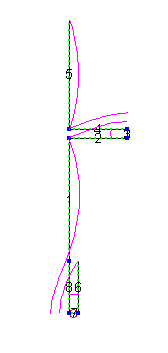
The Collinear Antenna has been around for a very long time and is a good simple antenna to construct. As noted in the EZNEC shootouts referenced in the list above, many attempts to improve straight forward antenna designs, like the half-wave antennas, result in mixed results. These “buzzword antennas” often function, but often with more materials – like the Collinear 5/8 Wave J-Pole; Who wants less performance with more copper?
I am thankful for programs like EZNEC that allow one to get a rough order look at new antenna topologies and quit guessing. There seems to be a popular notion antennas that provide a good match to the coax for low SWR perform quite well as a radiator. If you have not already noticed, dispelling this myth is a chief goal of Ham Help Desk.
Anyway, as you look at the Half-Wave Collinear J-Pole antenna in the right figure you can see how the lengths were adjusted until the peak currents were centered in each of the two vertical sections. It is a bit hard to see, but sections #1 and #5 form the two half-wave radiation conductors. By the way, all of these conductors are simulated with 1/2 copper pipe – the material used for this antenna. The bottom sections, #6,7, and 8, form the J of the J-Pole and are essentially a half-wave total length. Sections #2, 3 and 4, form the all important 180° delay section to ensure the top half of the antenna radiates in phase with the bottom (rather than out of phase like the debunked 5/4 Wave antenna).
A future post will go into more detail about this antenna. For now, know that we procrastinated and did nothing for this antenna until the very weekend of the Golden Packet event (a Sunday). All parts were purchased on Saturday morning, pipe cutting and soldering performed on Saturday night, test assembly and tuning done on Sunday morning (real early) and hauled untested to the mountain top Sunday midday. Folks, this is not the way to live your life, but EZNEC predictions seemed to work just fine.
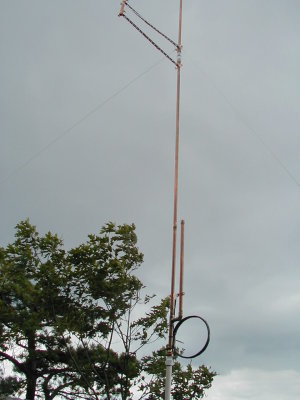
…and here it is on the edge of White Rock Cliffs. The 180° phase delay section was, at the last minute, changed from soldered copper pipe to a strange combination of copper pipe hanging straps, brass hardware and a short vertical piece of copper pipe. For the Golden Packet, I assembled this part with a total length prescribed by EZNEC and left it at that. Eventually, the adjustable nature of these copper straps will allow me to tweak the tuning at leisure.
All the antenna pieces breakdown into backpack size items with the exception of the two radiator elements. These two pieces are carried by hand with ease by the hikers. If desired, the radiator sections can be split with a coupler soldered to one of the pipes to allow all pipes to fit inside a backpack. I decided against this for now as I was not sure how flimsy this contraption would be on a windy mountain top.
Did we really need a complicated antenna with a view like this?
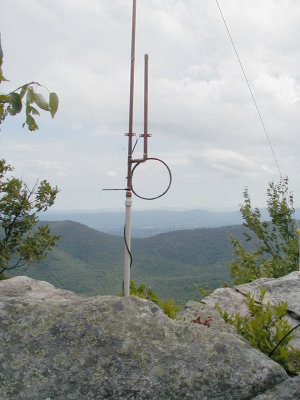
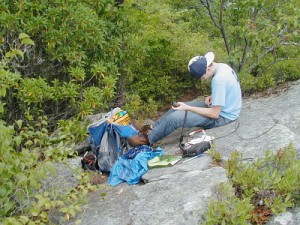
This is an excellent question. As soon as I tuned up the Kenwood TM-700A on 144.390 APRS, packets came screaming in from all over. I could here tens of packets per second. Eventually I configured the radio to the preset PM5 memory which uses 144.340 as the Golden Packet test frequency. To put it bluntly, there were no issues getting maximum signal to/from the north Maryland Mountains and south Apple Orchard locations. Note there was no APRS participant heard at Apple Orchard, but I could hit the voice repeater located there with no problems. Would a rubber ducky antenna work too? Perhaps as this mountain top location was like shooting fish in a barrel. At least my Collinear Half-Wave J-Pole didn’t not work. Unfortunately I could not locate my HT to test the rubber ducky idea… next year perhaps.
Here are kx4o and kj4faj learning how to use the Kenwood TM-700A radio…
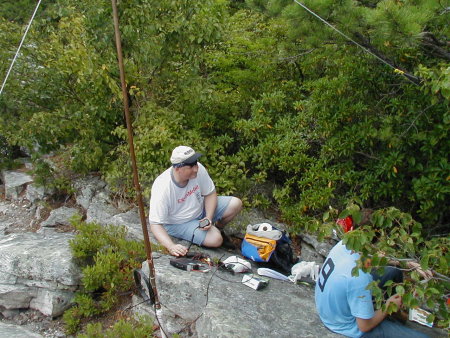
Rob Searle, the most athletic of our foursome, poses with the antenna…
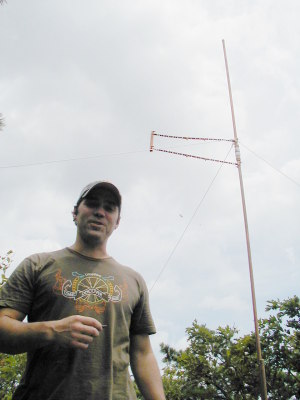
Kudos
“Thank you” cannot be said often enough for the help provided by Rob and Jay during this Golden Packet hiking “mission.” They both are clearly active people. They and my son are in far better shape than me as they often would climb the hill at a faster pace that I could possibly hold. It worked out well though. Jay provided help with navigation using the essential Map from PATC, Rob hauled my pack part of the way up the hill giving me a needed break and both located rock overhang cover in case we needed to hide from the nearby thunderstorms.
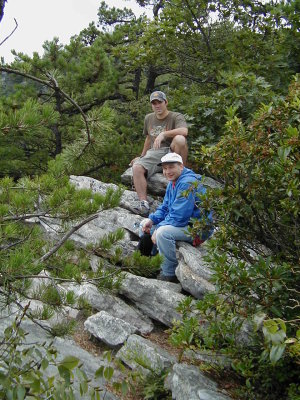
Thanks also to the SkyWarn Network working out of the 147.300 repeater who, as soon as they knew we were near local thunderstorms, provided updates to alert us of impending danger. We had lightning nearby, but it never came… too close?!?!?! We were ready to dive into the rock shelter located by Jay and Rob at a moment’s notice.
More Pictures

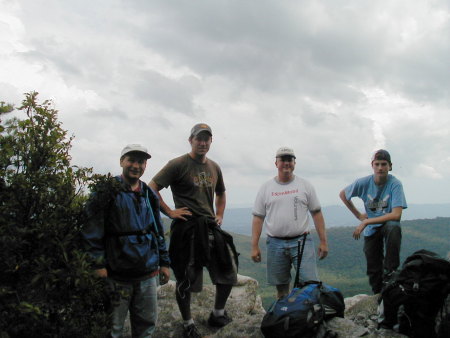
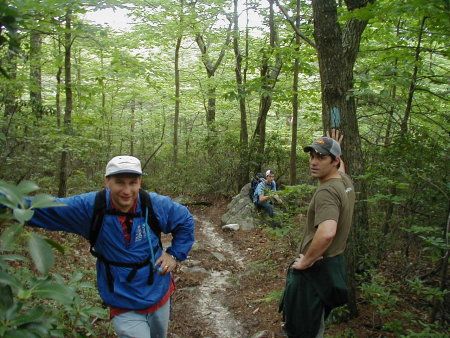
Final Thoughts
- The PATC Trail Map was essential to get us on the right path in the beginning of our ascent – well worth the $6 plus shipping.
- Having “real” hikers as part of the group was essential to bring proper experience to the crew.
- I busted my butt in the Gym the last two months preparing for this, but still have a long way to go when I compare myself to the in shape hiking peers.
- I made several 146.520 MHz simplex contacts plus hit my Warrenton home-town repeater with ease.
- I contacted Bob Bruninga, the organizer of the Golden Packet Test, on two different repeaters and I got confused at first because I was, at first, barely hearing one of the repeaters. I quickly realized I was hearing another repeater on the same frequency much farther away.
- My son and I purchased new backpacks for this event. The new packs offer a place to store a good supply of water fed to the hiker via a convenient tube. Nice.
- One 7 amp-hour gel cell powered the whole event just fine. I was skeptical at first, but am now a believer. We brought two 7 AH cells just in case, but did not need the second one.
- I am reasonably happy with the Hiker Collinear J-Pole, especially after the short build time, but hope to refine it a bit. That’s for another post.
This was a fun event and I hope to repeat it again next year.
John
de kx4o
Future non-fat ham.
